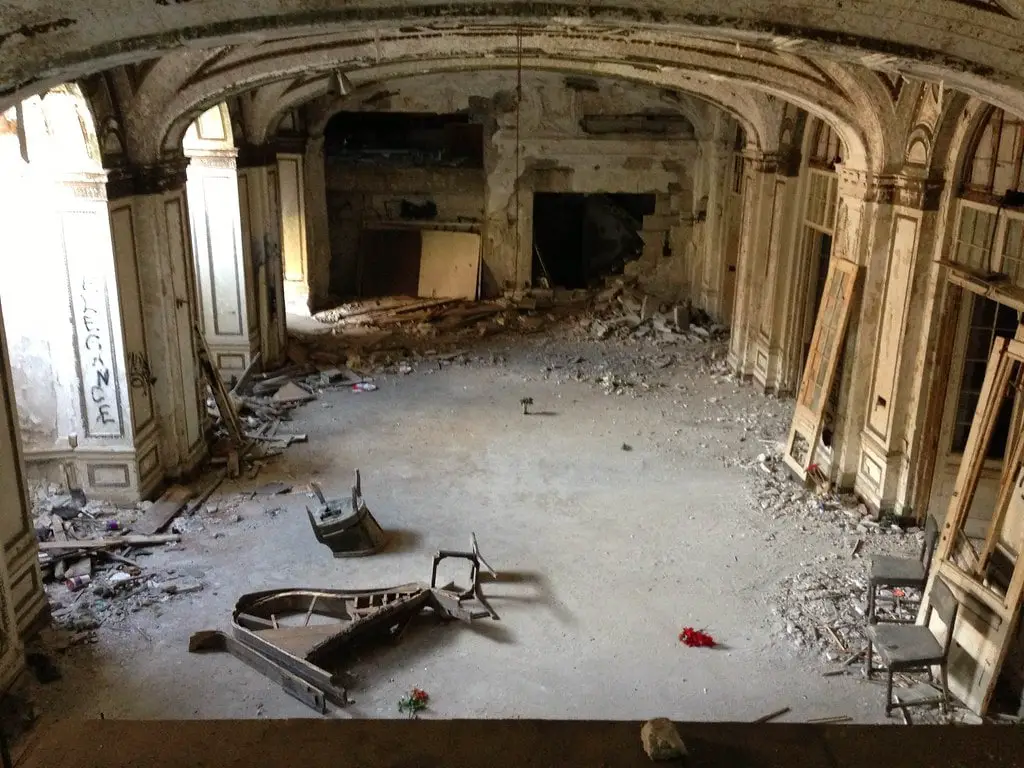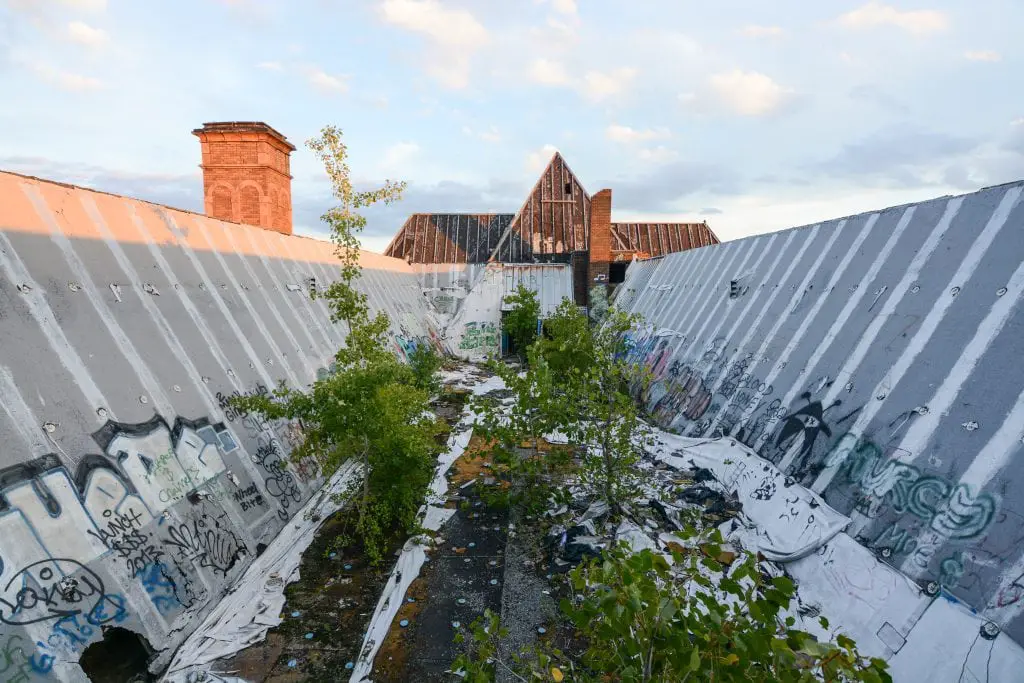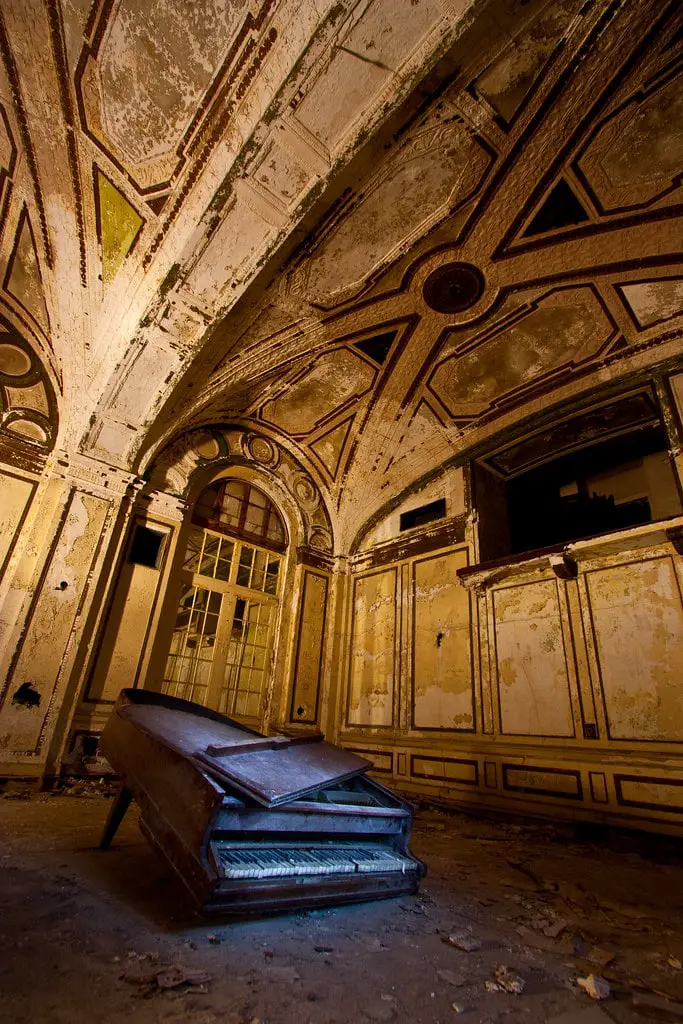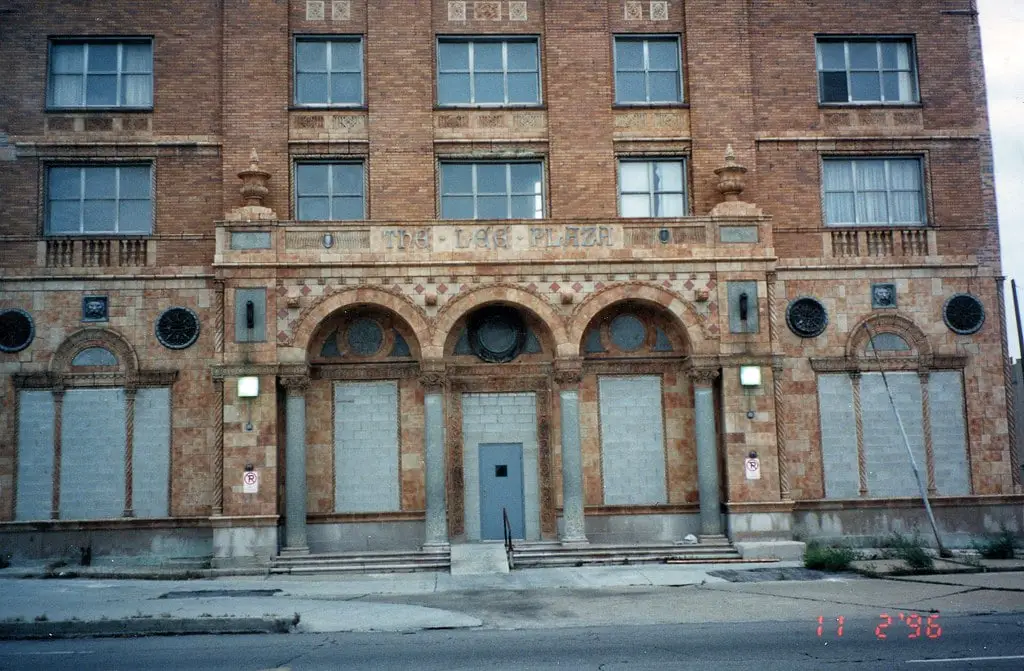The Birth of a Detroit Icon
Once a towering symbol of Detroit‘s prosperity, Lee Plaza has a history that is as rich as tumultuous. Built in 1927, the Art Deco masterpiece was the brainchild of Ralph T. Lee, a prominent real estate developer.
Lee envisioned a luxurious residential hotel rivaling the grandeur of Manhattan’s Fifth Avenue apartments. To bring this vision to life, he enlisted the talents of architect Charles Noble, and together, they embarked on a project that would cost a staggering $2.5 million—equivalent to about $31 million today.
The construction of Lee Plaza was significant in Detroit’s architectural history. The building was designed to rise above the stately elms of West Grand Boulevard at Lawton Avenue, standing as a testament to the city’s booming real estate market. The 17-story structure was adorned with intricate Art Deco details, making it one of Detroit’s most visually striking buildings.
The grand opening of Lee Plaza took place on December 1, 1927. The event was a spectacle, drawing attention from the city’s elite and marking the building as a symbol of opulence and luxury. With 220 high-class apartments, Lee Plaza was not just a place to live but a statement of affluence and sophistication.
However, the glory days of Lee Plaza were short-lived. The Great Depression hit Detroit hard, and the building, once a symbol of prosperity, reflected the city’s financial struggles. Despite its initial success, Lee Plaza was about to face challenges that would begin its decline.
A Life of Luxury and Extravagance
The interior of Lee Plaza was nothing short of extravagant. The building offered a range of amenities that were considered luxurious even by today’s standards.
From beauty parlors to game rooms equipped with driving nets for golfers, Lee Plaza was designed to provide a complete lifestyle experience. The basement even housed a meat market and a grocer, ensuring residents didn’t have to step outside for their daily needs.
Orpha Mae, Ralph Lee’s wife, played a significant role in the interior decorating of the building. The couple traveled to New York City to buy high-end furniture and to get inspiration from other luxury apartment hotels. The result was a building filled with marble, expensive wood, and elaborate plasterwork, all carefully chosen to create an atmosphere of luxury.
In an era when Detroit‘s real estate and housing market was booming, residential hotels like Lee Plaza offered a unique living experience. Residents enjoyed residing in luxury apartments while benefiting from hotel-like amenities, including room and concierge services. The apartments ranged from one to four rooms, with the smaller units fully furnished.
However, the extravagant lifestyle that Lee Plaza offered came at a cost. The building’s opulence was its downfall during the economic hardships of the Great Depression. The high maintenance costs and declining number of affluent residents led to financial troubles plaguing Lee Plaza for years.
Financial Troubles and Legal Woes
Financial difficulties plagued Lee Plaza shortly following the start of the Great Depression. Although Ralph Lee had transferred ownership of the hotel to Detroit Investment Co., the company failed to meet its payment obligations by December 1930. This led to a series of legal battles, with the Metropolitan Trust Co. initially appointed as the receiver, only to go into receivership itself.
In 1931, the Equitable Trust Co. took over the management of Lee Plaza and appointed Ralph Lee as an adviser. However, this arrangement led to further legal complications. Bondholders accused the administration of being lax and wasteful, leading to a court case in which Ralph Lee was found in contempt and ordered to pay $30,000 to the bondholders.

The legal woes didn’t end there. In 1935, Ralph Lee admitted in court to operating a hardware company almost solely to sell supplies to Lee Plaza at retail prices. This revelation led to further legal actions, culminating in the building going bankrupt by the fall of 1935.
The building remained tied up in legal battles for nearly a decade. It wasn’t until 1943 that Charles A. Owen, a Detroit real estate dealer, acquired Lee Plaza for $475,585. However, by this time, the building had lost much of its original luster and struggled to retain residents.
Transformation into Low-Income Housing
In a twist of fate, Lee Plaza was sold to the City of Detroit in January 1969. Once a symbol of affluence, the building became housing for low-income senior citizens. The City of Detroit modernized the building, adding new kitchens and elevators, and put it under the control of the Housing Commission.
The transformation was part of a more significant trend in Detroit, Michigan, as the city lost residents and faced a growing number of empty or financially troubled apartment buildings. Lee Plaza was not the only building to undergo this transformation, but its conversion was significant given its historical and architectural importance.

In 1981, Lee Plaza was added to the National Register of Historic Places, a recognition that highlighted its architectural significance. However, this designation did little to prevent the building’s decline. By the late 1980s, maintenance issues plagued the building, and the Housing Commission struggled to keep up with repairs.
Decay and Vandalism
Lee Plaza was officially closed in 1997, and the building quickly decayed. The once-grand structure became a target for vandals, who stripped it of its valuable architectural elements. Terra cotta lion heads, ornate railings, and other decorative features were stolen, leaving the building a shell of its former self.
The building’s closure had a significant impact on the surrounding neighborhood. Once a bustling area, the vicinity around Lee Plaza became increasingly desolate, contributing to the overall decline of Detroit’s West Side. The building symbolized the city’s struggles, empty windows, and crumbling facade, starkly contrasting with its former glory.

As of 2023, the building remains in a state of disrepair. Despite its addition to the National Register of Historic Places and its architectural significance, Lee Plaza has been unable to escape the cycle of decay and vandalism that has plagued it for years.
The building’s current state is a sad reminder of what it once was. However, it also serves as a cautionary tale for other historic buildings in Detroit, highlighting the importance of preservation and community involvement in maintaining the city’s architectural heritage.
Attempts at Restoration and Future Prospects
There have been renewed efforts to breathe life back into Lee Plaza in recent years. In February 2019, Detroit announced a significant development plan involving a joint venture between the Roxbury Group and Ethos Development Partners.
The $350,000 deal aimed to transform the building into a mixed-use space featuring 180 residential units and retail spaces. The first phase of this ambitious $60 million project was slated to begin in 2022, focusing on rehabilitating nine floors into 117 apartments specifically for income-eligible seniors.

Fast forward to January 20, 2022, a more detailed plan for the building’s restoration was unveiled. This multi-year, multi-phase development was broken down into two main phases. The first phase, costing $59 million, would restore the building’s first-floor main lobby and create 117 affordable senior apartments on floors 2 through 10.
The completion of this phase was scheduled for 2024. The second phase, with a budget of $20 million, aimed to develop 60 to 70 market-rate apartments on floors 11 through 16, with an expected completion date in 2025.
However, as of September 2023, the restoration project has faced delays due to rising construction costs. The financial gap in the project’s budget has been a significant hurdle, although state budget earmarks have been made to cover some of the costs.

Despite these challenges, the building’s future still holds promise. The delays are setbacks, but they are not definitive roadblocks. The city and the involved development groups are actively seeking solutions to move forward with the restoration. As Detroit continues its journey of renewal and growth, the hope remains that Lee Plaza will follow suit, reclaiming its place as an iconic part of the city’s skyline.
Lee Plaza in the Context of Detroit’s Urban Landscape
Lee Plaza is more than just a building; it reflects Detroit’s complex history and ever-changing urban landscape. Its rise, fall, and potential resurgence offer valuable insights into the challenges and opportunities of restoring historic structures in a city undergoing transformation.
The building is a focal point for discussions about urban decay and revitalization in Detroit. Its history mirrors the city’s trajectory, from the boom years of the early 20th century to the struggles of the late 1900s and the cautious optimism of the present day.

For many Detroiters, Lee Plaza is a poignant reminder of a bygone era. Its current state may be far from its days of luxury and opulence, but it remains a significant part of the city’s architectural and cultural heritage.
As Detroit continues to evolve, the story of Lee Plaza serves as both a cautionary tale and a source of inspiration. It’s a testament to a city’s resilience that has faced numerous challenges but continues to look toward the future with hope and determination.
Conclusion
The story of Lee Plaza is a complex tapestry woven from the threads of Detroit’s rich history, architectural heritage, and social dynamics. From its abundant beginnings to its current state of decay, the building has been a constant presence in the city’s ever-changing landscape.
As Detroit navigates the challenges and opportunities of the 21st century, the fate of Lee Plaza hangs in the balance. While its future remains uncertain, the building’s past is a powerful reminder of preserving architectural landmarks as part of a city’s heritage.

The ongoing efforts to restore Lee Plaza offer a glimmer of hope. With suitable investment and community support, this iconic building has the potential once again to become a symbol of Detroit’s resilience and ingenuity.
In the end, the story of Lee Plaza is not just about a building; it’s about a city and its people striving to reclaim their past while building a brighter future.
